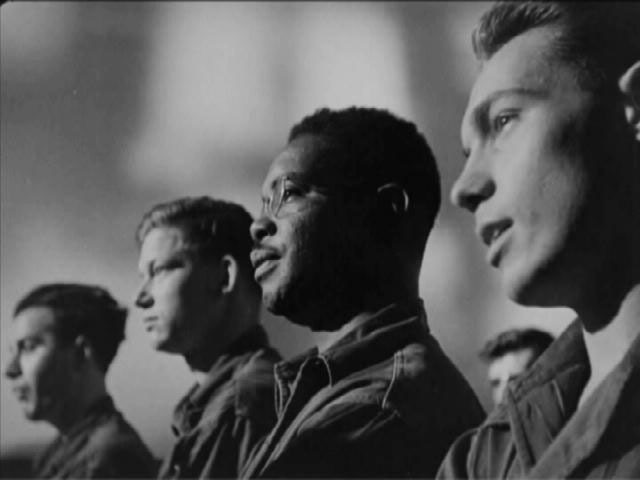Long after my father had forgotten my name, he remembered being a soldier.
My dad served in World War II. As an Army lieutenant, he navigated bombing runs in the European theatre. Like so many men of his time and generation, he never talked much about the war, although in his final years, even as he lost awareness of the world, fragments of his military experience emerged.
At times he would stand at attention, as if in the company of a phantom commanding officer. At times he world say things that clearly related to a period in his life he had never talked about before.
That was war: Unexpressed until later, until too late.
A similar suppression happened to Let There Be Light, a film directed by John Huston, who served in the Signal Corps where he made movies for the Army. (Huston also directed The Maltese Falcon, The Treasure of the Sierra Madre, The Misfits, The Man Who Would Be King, The Dead. He was an American cinema hero.)
It was Monday, June 3, 1946.
At New York’s Museum of Modern Art, with an audience gathered in the lobby, two Army officers walked into the projection booth and confiscated the movie.
Let There Be Light was a documentary Huston had made about returning WWII vets. It was so honest about what war does to men that the Department of Defense suppressed it for 35 years.
In time for Memorial Day, Let There Be Light has just been restored, and a link to watch it is at the bottom of this article.
Huston’s documentary was revolutionary for its time. He and his crew shot an unprecedented 375,000 feet of film to make this 58-minute movie. They pioneered the cinema verité technique, documenting returning soldiers, suffering from what today we call PTSD, as they spoke to psychiatrists about their trauma.
Of course, no one had a name for Post-Traumatic Stress Disorder back then. The original name of the movie was The Returning Psychoneurotics, reflecting a clinical term from an earlier era in psychiatry. Some of the scenes, as the men recall their experiences, are among the most moving depictions of war’s effects ever recorded.
While the public didn’t see the film, a few critics did, making it a movie the public could only read about. Most incisive in his writing was James Agee, in The Nation: “Let There Be Light, John Huston’s intelligent, noble, fiercely moving short film about combat neurosis and some of the more spectacular kinds of therapy, will probably never be seen by the civilian public for whose need, and on whose money, it was made. The War Department has mumbled a number of reasons why it has been withheld; the glaring obvious reason has not been mentioned: that any sane human being who saw the film would join the armed services, if at all, with a straight face and a painfully maturing mind…. I don’t know what is necessary to reverse this disgraceful decision, but if dynamite is required, then dynamite is indicated.”
There’s no direct relationship between my dad’s military service and Huston’s film. But indirectly, they’re linked in my mind. Cultural suppression breeds personal repression.
My dad was a great father, provided for our family and raised us well. Although he didn’t talk much about the war, we talked about plenty of other things. He kept his dark green Army uniform hanging in the closet, and, in a cardboard box, his military cap and service medals. We still have them.
Let There Be Light was restored by the National Film Preservation Foundation. You can watch it for free, in its entirety, on their website, here: http://www.filmpreservation.org/preserved-films/screening-room/let-there-be-light-1946
Film facts: James Agee later wrote the screenplay for The African Queen (1951), which Huston also directed. Let There Be Light is narrated by John’s father, Walter Huston, whom movie buffs may remember as Mr. Scratch in The Devil and Daniel Webster. The music is by Dmitri Tiomkin, who also scored High Noon, The Guns of Navarone, Dial M for Murder, Rio Bravo, Red River, Strangers on a Train, Mr. Smith Goes to Washington and Meet John Doe.

